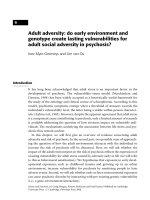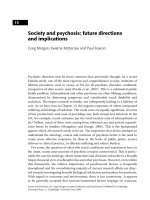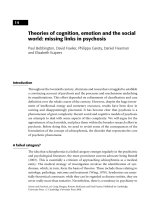Childhood adversity and psychosis
Bạn đang xem bản rút gọn của tài liệu. Xem và tải ngay bản đầy đủ của tài liệu tại đây (137.74 KB, 17 trang )
7
Childhood adversity and psychosis
Helen Fisher and Tom Craig
Introduction
Back in the 1950s and 1960s, it was popular to insinuate that the development of
mental health problems, particularly schizophrenia, was a result of being brought up
in a disturbed family (see Chapter 8). Unfortunately, this led to a family-blaming
culture based on little evidence, which, not surprisingly, was met with anger from
relatives’ support groups. Subsequently, few psychosis researchers have explored
potential risk factors relating to the family. However, in the past few years there has
been a resurgence of research into how the family environment and adverse childhood
experiences may be linked to later development of psychosis (see also Chapter 8). This
area of research appears to have come almost full circle and careful consideration of
recent research is essential if simplistic and potentially harmful conclusions are to be
avoided. In this chapter, we focus on childhood adversity, and begin with a review of
the most commonly researched aspects of early adversity and trauma.
Summary of existing literature
Separation from parents or loss of at least one parent
Recent investigations employing reasonably robust methodologies have found a
twofold to threefold increased risk of adult psychosis in those who experienced
long-term separation from, or death of, at least one parent during childhood,
independent of a variety of confounders, including a parental history of mental
illness (e.g., Morgan et al., 2007). Moreover, an increased risk of psychosis has been
found in those who lived in a single-parent household during childhood (Wicks et al.,
2005) and in those who spent time in institutional care (Bebbington et al., 2004). It
remains unclear, however, whether these associations reflect a direct effect of parental
separation and loss on risk of psychosis, or whether such events are proxy indicators
forassociatedadversity,suchasfamilyconflict and socioeconomic disadvantage.
Society and Psychosis, ed. Craig Morgan, Kwame McKenzie and Paul Fearon. Published by Cambridge
University Press. # Cambridge University Press 2008.
Childhood abuse
Significant proportions of patients with schizophrenia-spectrum disorders report
histories of childhood abuse. For instance, Morgan and Fisher (2007), in their
comprehensive review, reported average rates of childhood sexual abuse for female
and male patients with a psychotic disorder of 42% and 28%, respectively, and
rates of childhood physical abuse of 35% and 38%, respectively. This compares
with general population figures of 11% for sexual abuse and 7% for physical abuse
(May-Chahal and Cawson, 2005). In patients with other disorders, such as bipolar
affective disorder (Hammersley et al., 2003), post-traumatic stress disorder (Butler
et al., 1996) and dissociative identity disorder (Ross, 1989), experience of early
maltreatment is also positively correlated with increased levels of auditory hallu-
cinations and delusions. More recent studies using community samples have
found that schizotypal features are more common in those who report adverse
childhood experiences (e.g., Startup, 1999). Some research has also suggested that
parental neglect during childhood is associated with higher rates of schizophrenia
during adulthood (e.g., Jones et al., 1994).
Furthermore, several large general population studies have found childhood
maltreatment to be a significant predictor of later development of psychotic
symptoms (Bebbington et al., 2004; Janssen et al., 2004; Spauwen et al., 2006;
Whitfield et al., 2005). The Janssen et al. (2004) study is particularly noteworthy.
The study was a prospective investigation of 4045 people in the Netherlands.
Information on the experience, frequency and severity of various forms of abuse
(physical, sexual, psychological and emotional) was collected at the beginning of
the study and the sample was followed up over the subsequent two years to record
all new cases of psychosis. Those who reported having been abused were seven
times more likely than those without an abuse history to develop a psychotic
disorder warranting treatment, after controlling for a range of possible confound-
ing variables, including the presence of psychiatric problems at baseline and
lifetime illicit drug use. However, the number of individuals with psychotic
symptoms of a severity requiring care was small (n ¼ 7). The other population-
based studies are also limited as they failed to take account of the timing, severity
or duration of abuse (e.g., Bebbington et al., 2004; Spauwen et al., 2006), or
because they used a single question to measure psychotic symptoms (e.g.,
Whitfield et al., 2005). Moreover, the only study using contemporaneous records
found no association between officially reported childhood sexual abuse and later
hospital admission for schizophrenia (Spataro et al., 2004). This non-significant
finding could be due to a large number of sexual abuse cases going unreported in
the general population or the possibility that intervention by state services pro-
vides a protective effect. These inconsistencies point to a need for more methodo-
logically robust research.
96 H. Fisher and T. Craig
Bullying
Bullying can be either direct (e.g., kicking, hitting) or relational (e.g., social exclu-
sion, name-calling) and is considered to occur within the context of a real or
perceived physical or psychological imbalance of power in which an individual is
chronically exposed to deliberate harm or suffering by at least one other person
(Olweus, 1993). Although psychiatric problems and utilisation of mental health
services have been found amongst both bullies and their victims (Kumpulainen
et al., 1998), relatively few studies have considered these roles in terms of increased
susceptibility to psychosis in adulthood. To date, there do not appear to be any
studies exploring the rate of childhood bullying amongst psychotic patients, but two
general population studies have demonstrated that this adverse experience signifi-
cantly increases the risk of psychosis-like experiences in adolescence (Lataster et al.,
2006) and probable psychotic disorder in adulthood (Bebbington et al., 2004). In the
latter survey, those with a history of bullying victimisation were four times more
likely to self-report psychotic symptoms, although this was reduced to less than
twice after other types of victimisation were taken into account (Bebbington et al.,
2004). Moreover, bullying seems to have a persistent effect on individuals’ subjective
wellbeing after the development of non-affective psychosis (Hardy et al., 2005), thus
also potentially having an impact upon recovery.
Parental mental illness
Rutter and Quinton (1984) studied the offspring of consecutive new psychiatric cases
and found that around a third exhibited some form of persistent disorder. However,
few had a psychotic disorder. Moreover, this association is potentially confounded by
other factors prevalent in such families, including marital discord, parental separa-
tion, emotional deprivation and low socioeconomic status (Harris et al., 1987; Rutter
and Quinton, 1984). High rates of parental psychosis have been found amongst
severely abused children who came into contact with the judicial system in Boston
(Taylor et al., 1991). Consequently, having a parent with a psychotic disorder may
increase exposure to the types of early adversity that have been linked to the
subsequent development of psychosis. Disentangling the impact of these environ-
mental factors and genetic risk is a major challenge for future research.
Methodological issues
Defining adversity
A problematic aspect of the studies reviewed above concerns the definition and
assessment of the various forms of adversity. The concept of childhood adversity
encompasses a diverse range of experiences, including sexual abuse, physical
97 Childhood adversity and psychosis
abuse, emotional or psychological abuse, neglect, bullying by peers, parental loss
through separation or death, domestic violence and parental mental illness.
Within each of these broad categories there are considerable variations in quanti-
tative and qualitative aspects of the experiences that need to be taken into account.
These include the frequency and severity of exposure, contextual factors, such as
the age at which the exposure occurred, whether the perpetrator was a family
member or outsider, and the presence of other aspects of adversity that might
mitigate the likely impact. Some of these may include experiences, such as antipa-
thy or neglect, that would not qualify as abuse in their own right but might
nonetheless be important contributors to the overall impact. Different forms of
abuse tend to overlap. Parents who physically abuse their children also tend to
neglect them, and these different forms of adversity may have complex cumulative
effects (Mullen et al., 1993).
Measuring adversity
Most studies of early adversity and psychosis have relied on three sources of
information – clinical case notes or other official records (e.g., Read, 1998; Read
and Argyle, 1999; Read et al., 2003), self-report questionnaires (e.g., Whitfield
et al., 2005) or one or two questions within a larger interview (Bebbington et al.,
2004; Darves-Bornoz et al., 1995; Janssen et al., 2004). Each approach has serious
limitations. For example, abuse histories extracted from the records of psychiatric
patients suffer from all the definitional weaknesses mentioned above, are unreli-
ably recorded and consistently underestimate the prevalence of abuse (e.g., Read,
1998; Read and Argyle, 1999), particularly where reliance is solely on case notes
(Wurr and Partridge, 1996). Moreover, Dill et al. (1991) demonstrated that
confidential self-report questionnaires elicited twice as many reports of childhood
abuse as routine psychiatric intake interviews. Reports based on official court and
social service records of maltreatment are likely to be more carefully recorded and
accurate, but these legal samples are restricted to the more extreme end of the
spectrum. These samples may well exaggerate the importance of an association
between abuse and psychosis both because of the extreme nature of the abuse and
because these families may be dysfunctional in many other ways.
By far the most common measurement approach is one that relies on stand-
ardised questions. Typically, whether self-completed or by interview, standard
questions are asked that require ‘yes’ or ‘no’ responses and the number of positive
replies is used as the final measure. There are many problems with this approach.
What threshold of experience to include is left to the respondent and what might
be qualitatively quite different experiences are given the same score. Such checklist
measures often fail to deal with time order and do not always distinguish child-
hood and adult trauma. For example, one of the more commonly cited studies that
98 H. Fisher and T. Craig
found a link between sexual abuse and psychosis (Bebbington et al., 2004) did not
determine the timing of the experience and probably includes adult sexual assault,
which is considered by some authors to be more common than childhood sexual
abuse (Coverdale and Turbott, 2000).
Detailed questioning in semi-structured interviews has produced more accurate
recollections of adverse childhood experiences (Maughan and Rutter, 1997),
especially when given together with assurances about the confidential treatment
of disclosures (Dill et al., 1991). Additionally, the availability of a manual and the
need for training to be completed before administering the measure enhances
inter-rater consistency in administration and interpretation (Roy and Perry,
2004). Very few of the existing studies have employed tools with published
psychometric properties that meet such criteria (e.g., Fisher et al., 2006).
However, a few studies have attempted to rectify assessment problems and
enhance validity by assigning high cut-offs to their definitions of adversity to
capture only severe and persistent cases of childhood maltreatment (e.g., Janssen
et al., 2004). Similarly, in studies that have not employed specific tools to assess
childhood abuse, such as Read et al. (2003), in which medical notes were screened,
inter-rater reliability has occasionally been determined to check the consistency
with which definitions of abuse have been applied (e.g., Read, 1998).
Of course it is not only the adversity that needs careful consideration. Psychosis
and schizophrenia are broad, heterogeneous constructs and it may be too limiting
merely to consider correlations involving patients who have received such diag-
noses. Greater understanding may be reached by focusing on specific psychotic
symptoms or ‘complaints’ (see Chapter 14). However, some studies have
employed inadequate measures of such symptoms. For example, Whitfield et al.
(2005) used a single question to determine the presence of hallucinations in their
participants. Moreover, many studies have not specified which psychotic symp-
toms or types of trauma are being measured. Those that do often have sample sizes
that are too small to detect associations between the different forms of adversity
and psychosis (e.g., Bak et al., 2005). Others have focused on just a single type of
adversity (e.g., Darves-Bornoz et al., 1995), preventing the potentially confound-
ing effects of other types of abuse from being controlled.
Validity and retrospective assessment
The accuracy of recall of childhood maltreatment is contentious. In addition to the
normal processes of forgetting over time, the traumatic nature of adversity may
result in amnesia for such experiences (Feldman-Summers and Pope, 1994).
Unfortunately, there is no easy way of removing the need for retrospective assess-
ment for anything other than the most severe forms of neglect and abuse that come
to the attention of social services.
99 Childhood adversity and psychosis
Consequently, assessment tools have employed devices to minimise potential
problems with recall. For instance, the Childhood Experiences of Care and Abuse
interview (CECA: Bifulco et al., 1994) and a shorter investigator-administered
screening questionnaire (CECA-Q: Bifulco et al., 2005) were developed to focus on
factual aspects of behaviours, and require the respondents to give concrete exam-
ples of abuses that they have experienced. The interview starts with mapping the
household arrangements from early childhood to the age of 17 and covers the care
received from both parents and other carers. These, together with key dates
(birthdays, major events), are then used to frame questions and trigger the
individual’s memory of past events. However, only two studies involving patients
with psychotic conditions have employed these approaches (Fisher et al., 2006;
Friedman et al., 2002).
Additional concerns about the reliability of patients’ recall of abuse histories
have been raised based on the cognitive impairments associated with psychotic
disorders (Saykin et al., 1991) or the perception that such patients are more likely
to report delusional accounts of abuse (Young et al., 2001). Although there is a
large body of literature indicating that individuals with psychosis experience
difficulties in acquiring, retaining and retrieving new information (Goldman-
Rakic, 1994), there is no clear evidence of similar deficits with regard to informa-
tion stored in the long-term memory (Gur et al., 2000). Several reviews have
concluded that current psychopathology does not result in biased memories of
childhood abuse (e.g., Maughan and Rutter, 1997). Reports of abuse by adult
psychiatric patients have been shown to be reasonably reliable over time
(Goodman et al., 1999) and reports by those with schizophrenia have been
found to be as reliable as those made by the general population (Darves-Bornoz
et al., 1995). Indeed, patients may be more likely to under-report instances of
abuse (Dill et al., 1991).
Sample characteristics
Reasonably large numbers of participants are required to test statistically for
effects, control for confounders and explore the differential influence of various
types of abuse on risk of psychosis (Read et al., 2005). However, even the large
general population studies only identified a small number of people with probable
psychosis (n ¼ 60: Bebbington et al., 2004; n ¼ 7: Janssen et al., 2004). Moreover,
many studies have been based on samples of inpatients suffering from chronic
disorders, which are not representative of the broader population of individuals
with psychosis (Saleptsi et al., 2004), let alone the many people who experience
transient conditions or those who experience psychosis but do not seek treatment.
It is consequently not clear from such studies whether the childhood trauma is
associated with the onset or the course of the disorder.
100 H. Fisher and T. Craig









